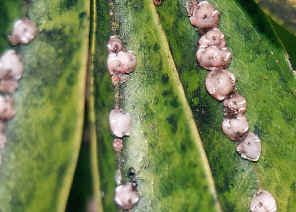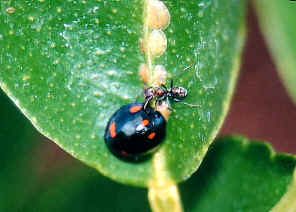|
|
Scale Insects, Soft Scales, Wax Scales
Family Coccidae
The insects in this family are covered with wax secretion. The covering may be scale-like or mussel-shaped. From their appearance they do not look like insect. Young scale insects may still look like an insects, but they are very small. When they grow, most of their external organs, such as their legs, wings and antenna, are reduced and become functionless.
The young scale insects have three pair of legs, known as 'crawlers'. It is their responsible for spreading and look for suitable place to start new colony. Because they are very small, even they have no wings, they can spread by wind borne. When the females settle, they seldom move. Male adults are winged.
- Pink Wax Scale, Chinese Wax Scale, Hard Wax Scale


- Ceroplastes sp. (most likely Ceroplastes rubens), diameter 5mm
- They affect different type of board leaf plants in Brisbane garden. The insects live under the protected shell cover, which is their pink waxy secretion. Notice the sooty mould that they induced. The insects suck the plant juice. Within the juice, there are water and sugar more than the insects need. They are excreted as honeydew. This induces the mould and attracts ants. The adults are well under protection. Some ladybirds are the predators of their young.
- Reference:
- 1. A field guide to insects in Australia - By Paul Zborowski and Ross Storey, Reed New Holland, 1996, p86.
- Cotton Scale


- Pulvinaria sp., diameter 8mm
- This Scale Insects can be find on Citrus plants. The white and fluffy substance is the egg sac. Eggs are laid into the soft wax, the female's body is lifted up. The second picture shows two ladybird larvae feeding on the scale insects on a Citrus leaf.
- Wattle Tick Scale


- Cryptes baccatus diameter 5-10mm
- This Scale Insects form large ball shaped 'scale'. The first picture shows some ants are attending them for their honey drew. They are found on different species of Acacia trees. More information and pictures can be found in this page.
- Nigra Scale

- Parasaissetia nigra sp. length 5mm
- In the above picture there are the black adult females, some pale-yellow slightly smaller later instars and some small pale-yellow crawlers (1st instars). Nigra scale is parthenogenetic and there are no males.
- Black Scale


- Saissetia oleae, length 3mm
- Above pictures show the Black Scales and their predator Orange-spotted Ladybird. We took pictures on a Citrus plant. the above pictures, The ladybird came to examine the Black Scale and encountered an ant. When the ladybirds hunt for scale insects, they will encounter different species of ants. Those ants come for the honey-dew from the scale insect. The ladybird helmet shape of wing-covers protect them those ants. They sit with legs and antenna hidden under the wing-covers. The ants just cannot do anything about them.
- Scale Insect on Banksia leaf


- ?sp., dia 5mm
